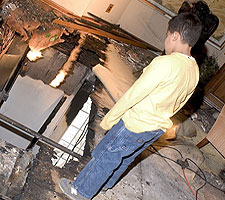What is the Attractive Nuisance Doctrine, and Why Should I Care?
Picture this. It’s 7:30 am the day after the Smith’s house caught on fire. Only a part of the house was damaged, and your station did a great job of putting the fire out and making sure the Smith’s were safe. Your engine went back into service and you are now heading home the next morning. Job well done!
Except, when you drive by the Smith’s at 7:30 am, you notice that little Billy Johnson from down the street is climbing through the broken window at the Smith’s house. You pull over, jump out, talk to Billy, and, once again, save the day. But what if you weren’t there when Billy was climbing through that window? What would have happened to him?
Children like Billy are naturally quite curious. These traits are important for learning and exploration, but can also land kids in dangerous situations. Everyday objects on other people’s property can irresistibly draw children onto the property, but also present them with hidden dangers.
Enter the Attractive Nuisance Doctrine, which states that a homeowner may be held liable for injuries to children trespassing on the property if the injury is caused by an object that is likely to attract children. The doctrine is designed to protect children who are unable to appreciate the risk posed by the object, by imposing the liability of the homeowner.
It’s very possible that the Smith’s, the homeowner in the above scenario, had no idea this doctrine even existed. But by leaving their house after the fire without securing the property, they have assumed a large risk and responsibility.
You, as a firefighter, can help the Smith’s and every other family like them by educating them about this doctrine. After a fire, victims feel lost and confused and look to their heroes for answers. You can be a knowledgeable resource for your community with this information to help protect them from future damage, like if Billy had broken his arm at their house. Below is a little more information about the Attractive Nuisance Doctrine from US Legal. At 1-800-BOARDUP, we can help with structural stabilization and securing property – don’t ever hesitate to call us for information or assistance.
Attractive Nuisance Law and Legal Definition
Attractive nuisance is a defense to trespass by children used in tort law. The doctrine of attractive nuisance is premised on the belief that one who maintains a dangerous condition which is likely to attract children on their property is under a duty to post a warning or take affirmative action to protect children from the dangers of that attraction. It imposes a duty to be sensitive to potentially dangerous conditions which are likely to attract children. The attractive nuisance doctrine typically doesn’t apply to adults. However, if a child is in danger due to an attractive nuisance and an adult attempts to rescue the child, the attractive nuisance doctrine may hold the landowner responsible for the rescuer’s injuries in addition to the child’s injuries.
It is an exception to the general rule that no particular care required of property owners to safeguard trespassers from harm. An attractive nuisance may be unenclosed pools, machinery or stacks of building materials — that present both an irresistible lure and hidden danger to young children. Most natural conditions, such as a lake or a naturally steep bank, are not considered attractive nuisances. To be liable for injury, an owner must create or maintain the harmful object.
A person’s ability to recover for an injury on another’s property, specifically in the case where the injury occurred in a pool, lake, pond, etc., depends on the category in which a court places the injured person. If a court categorizes a person as a trespasser, the law generally protects a property owner from liability in all cases where the trespasser sustains an injury, except when the owner acts “wantonly or willfully.” An exception to this rule, however, exists in the case of young children. For guests, or licensees, of a property owner, establishing liability for injury or death resulting from the use of a pool rests on the property owner’s failure to warn guests of dangers that the guests would otherwise not discover themselves. Some states’ courts have found that the danger of drowning or injuring oneself diving or swimming in a pool is “open and obvious.”
In evaluating whether a landowner is liable for an attractive nuisance a court may weigh:
- whether the landowner knew or had reason to know that children could trespass near the hazard;
- the type of hazard on the property and whether the hazard poses an unreasonable risk of death or serious bodily harm to children;
- whether the children, due to their youth, could appreciate the risk involved;
- the importance to the landowner of maintaining the hazardous condition;
- how the burden of eliminating the hazard compares to the risk of harm involved; and
- whether the landowner took reasonable precautions or exercised reasonable care to eliminate the hazard or to protect the children from harm.
Sources: https://realestate.findlaw.com/owning-a-home/dangers-to-children-attractive-nuisances.html

